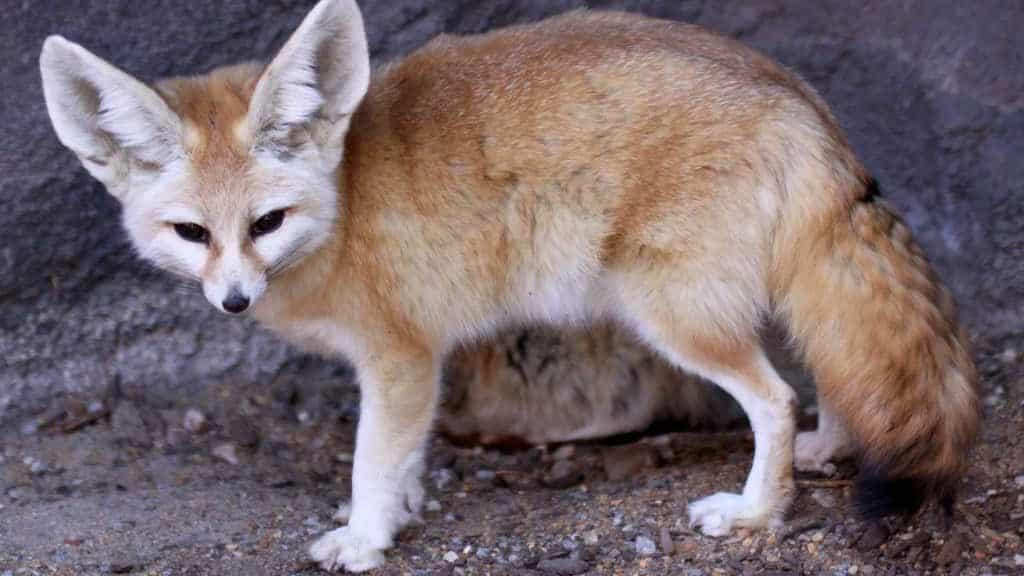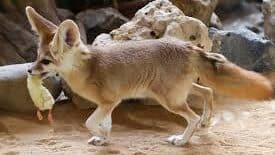The fennec fox (Vulpes zerda) stands as nature’s masterpiece of desert adaptation, captivating wildlife enthusiasts and researchers alike with its distinctive features and remarkable survival abilities. Native to the harsh, arid regions of North Africa and the Sahara Desert, this diminutive canid has evolved a suite of specialized characteristics that make it uniquely equipped to thrive where few mammals dare to venture. Weighing merely 1.5-3.5 pounds and measuring about 8 inches in height, the fennec fox holds the title of the world’s smallest canid species. But don’t let its tiny stature fool you—this resilient desert dweller possesses extraordinary adaptations that have allowed it to conquer one of Earth’s most unforgiving environments for thousands of years.
Those Extraordinary Ears

Perhaps the most iconic feature of the fennec fox is its disproportionately large ears, which can grow up to 6 inches long—nearly as long as its entire body. These remarkable auditory organs serve multiple crucial functions beyond their adorable appearance. Primarily, they act as highly efficient heat dissipators, working like natural radiators to release excess body heat into the environment, helping the fox maintain a stable body temperature in scorching desert conditions where temperatures routinely exceed 100°F during the day.
Additionally, these oversized ears provide the fennec with exceptional hearing capabilities, allowing them to detect prey moving underground or insects scurrying across the sand from considerable distances. They can even hear prey animals burrowing beneath the desert surface, giving them a significant hunting advantage in an environment where food sources are scarce and widely dispersed. This remarkable adaptation represents one of nature’s most elegant solutions to the dual challenges of thermoregulation and hunting efficiency in extreme environments.
Desert-Adapted Fur

The fennec fox’s cream-colored, luxuriously soft coat serves multiple adaptive purposes in its harsh desert habitat. The pale, sandy coloration provides excellent camouflage against the desert landscape, helping the fox avoid potential predators such as eagles, jackals, and the occasional caracal. This cryptic coloration allows them to blend seamlessly with their surroundings, making them virtually invisible when stationary on the desert sands.
Beyond camouflage, the fennec’s fur offers critical insulation against extreme temperature fluctuations. The dense underfur provides warmth during frigid desert nights when temperatures can plummet below freezing, while the reflective qualities of their light-colored outer coat helps deflect solar radiation during scorching days. Additionally, their fur-covered footpads provide crucial protection against the blazing hot sand, essentially functioning as natural sandals that allow them to traverse surfaces that would burn the paws of most other animals. This multifunctional coat demonstrates the remarkable efficiency of evolutionary adaptation.
Remarkable Water Conservation

Surviving in a landscape where rainfall might be measured in mere millimeters per year requires extraordinary water conservation strategies, and the fennec fox excels in this domain. Unlike most mammals, fennec foxes can survive with minimal free water, obtaining nearly all their hydration needs from their food sources. Their highly efficient kidneys concentrate urine to conserve water, while their respiratory system is adapted to minimize moisture loss through breathing.
The fennec’s diet contributes significantly to its water conservation strategy. By consuming moisture-rich foods like fruits, roots, and insects, they obtain vital hydration that would otherwise be unavailable in their parched habitat. Their bodies have also evolved to extract and retain the maximum amount of water from their food, with specialized digestive processes that minimize water waste. This comprehensive suite of adaptations represents one of the most sophisticated water conservation systems in the mammalian world, allowing fennecs to thrive in regions where water scarcity would prove fatal to most other mammals.
Social Structure and Family Bonds

Unlike many fox species that tend toward solitary lifestyles, fennec foxes display remarkably social behavior, living in small family groups or “communities” of up to ten individuals. These tight-knit units typically consist of a mated pair and their offspring from multiple breeding seasons. The social structure provides numerous survival advantages in their challenging environment, including cooperative den maintenance, territory defense, and in some cases, collaborative hunting or foraging.
The parental investment in fennec fox families is particularly noteworthy. Both parents participate in kit rearing, with males providing food for nursing females and later helping to teach young foxes essential survival skills. Kits remain with their parents for relatively long periods compared to other fox species, often staying with the family group until they reach sexual maturity at around 9-11 months. This extended family cohesion provides crucial learning opportunities for young fennecs to master the specialized skills required for desert survival, including hunting techniques, predator avoidance, and location of scarce water sources.
Impressive Burrowing Abilities

Fennec foxes are masterful excavators, creating elaborate underground den systems that can span up to 120 square feet and reach depths of 10 feet below the desert surface. These architectural marvels serve as essential refuges from extreme temperatures, with the deep earth providing natural insulation that maintains a relatively stable microclimate regardless of the punishing conditions above ground. The complex tunnel systems typically feature multiple entrances and chambers, including dedicated spaces for food storage, waste elimination, and nurseries for kits.
Their digging prowess comes courtesy of specialized adaptations, including powerful forelimbs and sturdy, slightly curved claws that efficiently move sand. A fennec fox can disappear beneath the desert surface with astonishing speed when threatened, vanishing into the sand within seconds. These dens represent not just temporary shelters but permanent homes that families may occupy for generations, with ongoing expansions and modifications. The temperature differential between the surface and the den interior can be as much as 30°F, making these subterranean havens crucial survival tools in an environment where exposure to midday heat or nighttime cold could prove fatal.
Omnivorous Dietary Flexibility

The fennec fox displays remarkable dietary versatility that allows it to exploit whatever food resources become available in its resource-limited environment. Their omnivorous diet includes insects (particularly locusts and grasshoppers), small rodents, lizards, birds and their eggs, as well as various plant materials including roots, berries, and fruits. This dietary flexibility proves essential in a habitat where any single food source may become temporarily unavailable due to seasonal changes or climate fluctuations.
Particularly fascinating is the fennec’s relationship with desert vegetation, especially the Acacia tree and its fruits, which provide not only nutrition but also crucial moisture. Their consumption of dates and other desert fruits contributes significantly to their water intake, while their predation on rodents helps control populations that might otherwise damage the sparse vegetation. Unlike many canids that rely primarily on meat, the fennec’s ability to efficiently digest plant material demonstrates specialized digestive adaptations. Their opportunistic feeding strategy, combined with remarkable food-finding abilities, allows them to maintain adequate nutrition despite living in one of Earth’s most food-scarce environments.
Nocturnal Lifestyle

The fennec fox has embraced a predominantly nocturnal existence as a strategic adaptation to the extreme heat of its desert habitat. By restricting most activity to nighttime hours when temperatures drop significantly, fennecs avoid the potentially fatal daytime heat that can exceed 120°F in summer months. This nocturnal pattern allows them to conserve precious water and energy resources that would otherwise be expended through daytime cooling mechanisms such as panting or seeking shade.
Their nighttime activities are supported by specialized sensory adaptations, including their extraordinary hearing and exceptional night vision. Their large eyes contain a high concentration of rod cells that maximize light capture in low-light conditions, while a specialized reflective layer called the tapetum lucidum enhances visual sensitivity by reflecting light back through the retina a second time. Combined with their acute hearing, these adaptations make fennec foxes formidable nighttime hunters. During daylight hours, they typically retreat to their cool underground dens, emerging at dusk to begin foraging and hunting through the desert night until dawn sends them back to their subterranean sanctuary.
Unique Vocalizations

The fennec fox possesses one of the most diverse vocal repertoires among canids, with a remarkable range of sounds that facilitate complex communication within their social groups. Their vocalizations include high-pitched barks, purring sounds reminiscent of domestic cats, soft whimpering, chattering, and perhaps most distinctive, a piercing scream that can carry across vast distances in the desert landscape. These varied sounds serve specific communicative functions, from territory defense warnings to mating calls and familial bonding vocalizations.
During the breeding season, male fennecs produce a distinctive hoarse bark to attract females and warn off rival males, while females use specific soft calls to communicate with their kits. The fennec’s vocal range extends well into ultrasonic frequencies that human ears cannot detect, allowing them a private communication channel that many potential predators cannot intercept. This sophisticated acoustic communication system enables complex social interactions and enhances survival through efficient information sharing about resources, dangers, and group movements across their territory, representing another remarkable specialization for desert living.
Exceptional Agility and Speed

Despite their diminutive size, fennec foxes possess extraordinary physical capabilities that enable them to navigate their challenging environment with remarkable efficiency. They can reach speeds of up to 20 miles per hour in short bursts—impressive considering their tiny stature—allowing them to capture swift prey like desert rodents and evade potential predators. Their agility is perhaps even more impressive than their raw speed, with the ability to change direction almost instantaneously and execute acrobatic leaps that can reach heights of over three feet.
The fennec’s lightweight frame and proportionally powerful hind limbs contribute to this exceptional mobility, as do their specialized foot pads which provide excellent traction on loose sand. They can traverse dune environments that would prove challenging for many larger predators, using their agility as both a hunting advantage and a defense mechanism. When hunting insects, fennecs display remarkable precision, using quick pounces and mid-air turns to capture flying insects. This combination of speed, agility, and precision movement represents yet another specialized adaptation that enables these tiny foxes to thrive in an environment where efficiency of movement can mean the difference between successful feeding and starvation.
Conservation Challenges

While currently classified as “Least Concern” on the IUCN Red List, fennec fox populations face increasing pressure from multiple human-related threats. Habitat loss due to urban expansion, agricultural development, and mining operations in North African desert regions continues to fragment their native range. The exotic pet trade presents another significant challenge, with fennecs being captured from the wild to supply demand in international pet markets, despite the fact that these specialized wild animals generally make challenging and inappropriate pets requiring expert care.
Climate change poses perhaps the most insidious threat, as shifting precipitation patterns and increasing temperature extremes may push even these desert specialists beyond their adaptive capabilities. Conservation efforts include habitat protection initiatives in countries like Morocco and Tunisia, captive breeding programs in zoological facilities, and educational campaigns to discourage the exotic pet trade. The fennec fox’s specialized adaptations, while remarkable, also make them particularly vulnerable to environmental changes that might disrupt the delicate desert ecosystems they’ve evolved to inhabit. Their future may depend on increased conservation focus and greater understanding of their ecological requirements.
The fennec fox stands as one of nature’s most compelling examples of specialized adaptation, demonstrating how evolutionary processes can craft extraordinary solutions to extreme environmental challenges. Every aspect of their biology—from their iconic ears to their specialized kidneys, from their social structure to their burrowing behavior—represents a refined response to the unforgiving demands of desert existence. Their success in one of Earth’s most hostile environments testifies to the power of natural selection to produce remarkably efficient biological systems. The fennec’s unique combination of adaptations has allowed this tiny canid to carve out a successful niche where few mammals could survive, making them true desert specialists. As we continue to study these remarkable creatures, they offer valuable insights into the limits of mammalian adaptation and provide inspiration for biomimetic solutions to human challenges in arid environments.
- What Makes the Fennec Fox So Unique - August 12, 2025
- How Dolphins Use Bubbles to Hunt - August 12, 2025
- Why Do Some Birds Lay Their Eggs in Other Nests? - August 12, 2025

